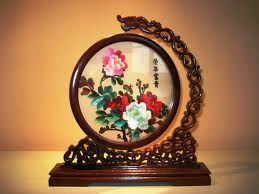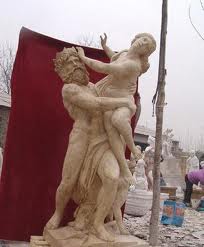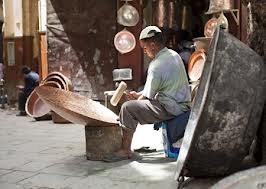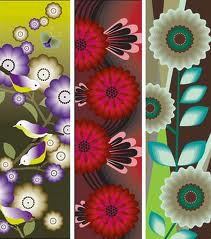Revival of Design and Handicraft
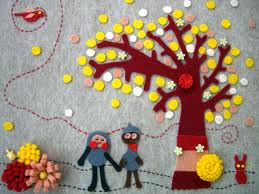
[ Source Info:
http://en.wikisource.org/wiki/Arts_and_Crafts_Essays/Of_the_Revival_of_Design_and_Handicraft ]
THE REVIVAL OF DESIGN AND HANDICRAFT
WITH NOTES ON THE WORK OF THE ARTS AND CRAFTS EXHIBITION SOCIETY
by Walter Crane
The decorative artist and the handicraftsman have hitherto had but little opportunity of displaying their work in the public eye, or rather of appealing to it upon strictly artistic grounds in the same sense as the pictorial artist; and it is a somewhat singular state of things that at a time when the Arts are perhaps more looked after, and certainly more talked about, than they have ever been before, and the beautifying of houses, to those to whom it is possible, has become in some cases almost a religion, so little is known of the actual designer and maker (as distinct from the proprietary manufacturer or middleman) of those familiar things which contribute so much to the comfort and refinement of life — of our chairs and cabinets, our chintzes and wall-papers, our lamps and pitchers — the Lares and Penates of our households, which with the touch of time and association often come to be regarded with so peculiar an affection.
Nor is this condition of affairs in regard to applied Art without an explanation, since it is undeniable that under the modern industrial system that personal element, which is so important in all forms of Art, has been thrust farther and farther into the background, until the production of what are called ornamental objects, and the supply of ornamental additions generally, instead of growing out of organic necessities, have become, under a misapplication of machinery, driven by the keen competition of trade, purely commercial affairs — questions of the supply and demand of the market artificially stimulated and controlled by the arts of the advertiser and the salesman bidding against each other for the favour of a capricious and passing fashion, which too often takes the place of a real love of Art in our days.
Of late years, however, a kind of revival has been going on, as a protest against the conviction that, with all our modern mechanical achievements, comforts, and luxuries, life is growing “uglier every day,” as Mr. Morris puts it. Even our painters are driven to rely rather on the accidental beauty which, like a struggling ray through a London fog, sometimes illumes and transfigures the sordid commonplace or everyday life. We cannot, however, live on sensational effects without impairing our sense of form and balance — of beauty, in short. We cannot concentrate our attention on pictorial and graphic art, and come to regard it as the one form worth pursuing, without losing our sense of construction and power of adaptation in design to all kinds of very different materials and purposes — that sense of relation — that architectonic sense which built up the great monuments of the past.
The true root and basis of all Art lies in the handicrafts. If there is no room or chance of recognition for really artistic power and feeling in design and craftsmanship — if Art is not recognised in the humblest object and material, and felt to be as valuable in its own way as the more highly rewarded pictorial skill — the arts cannot be in a sound condition; and if artists cease to be found among the crafts there is great danger that they will vanish from the arts also, and become manufacturers and salesmen instead.
It was with the object of giving some visible expression to these views that the Exhibitions of the Arts and Crafts Society were organised.
As was to be expected, many difficulties had to be encountered. In the endeavour to assign due credit to the responsible designer and workman, it was found sometimes difficult to do so amid the very numerous artificers (in some cases) who under our industrial conditions contribute to the production of a work.
It will readily be understood that the organisation of exhibitions of this character, and with such objects as have been stated, is a far less simple matter than an ordinary picture exhibition. Instead of having an array of artists whose names and addresses are in every catalogue, our constituency, as it were, outside the personal knowledge of the Committee, had to be discovered. Under the designation of So-and-so and Co. many a skilful designer and craftsman may be concealed; and individual and independent artists in design and handicraft are as yet few and far between.
However, in the belief, as elsewhere expressed, that it is little good nourishing the tree at the head if it is dying at the root, and that, living or dying, the desirability of an accurate diagnosis while there is any doubt of our artistic health will at once be admitted, the Society determined to try the experimentand so opened their first Exhibition.
The reception given to it having so far justified our plea for the due recognition of the arts and crafts of design, and our belief in their fundamental importance — the amount of public interest and support accorded to the Exhibition having, in fact, far exceeded our anticipations, it was determined to hold a second on the same lines, and to endeavour to carry out, with more completeness than was at first found possible, those principles of work, ideas, and aims in art for which we contended, and to make the Exhibition a rallying point, as it were, for all sympathetic workers.
Regarding design as a species of language capable of very varied expression through the medium of different methods and materials, it naturally follows that there is all the difference in the world between one treatment and another, both of design and material; and moreover, every material has its own proper capacity and appropriate range of expression, so that it becomes the business of the sympathetic workman to discover this and give it due expansion.
For the absence of this discriminating sense no amount of mechanical smoothness or imitative skill can compensate; and it is obvious that any attempt to imitate or render the qualities peculiar to one material in another leads the workman on a false track.
Now, we have only to consider how much of the work commonly produced, which comes under the head of what is called “industrial art,” depends upon this very false quality of imitation (whether as to design or material) to show how far we have departed in the ordinary processes of manufacture and standards of trade from primitive and true artistic instincts. The demand, artificially stimulated, is less for thought or beauty than for novelty, and all sorts of mechanical invention are applied, chiefly with the view of increasing the rate of production and diminishing its cost, regardless of the fact that anything in the nature of bad or false art is dear at any price.
Plain materials and surfaces are infinitely preferable to inorganic and inappropriate ornament; yet there is not the simplest article of common use made by the hand of man that is not capable of receiving some touch of art — whether it lies in the planning and proportions, or in the final decorative adornment; whether in the work of the smith, the carpenter, the carver, the weaver, or the potter, and the other indispensable crafts.
With the organisation of industry on the grand scale, and the enormous application of machinery in the interests of competitive production for profit, when both art and industry are forced to make their appeal to the unreal and impersonal average, rather than to the real and personal you and me, it is not wonderful that beauty should have become divorced from use, and that attempts to concede its demands, and the desire for it, should too often mean the ill-considered bedizenment of meaningless and unrelated ornament.
The very producer, the designer, and craftsman, too, has been lost sight of, and his personality submerged in that of a business firm, so that we have reached the reductio ad absurdum of an impersonal artist or craftsman trying to produce things of beauty for an impersonal and unknown public — a purely conjectural matter from first to last.
Under such conditions it is hardly surprising that the arts of design should have declined, and that the idea of art should have become limited to pictorial work (where, at least, the artist may be known, in some relation to his public, and comparatively free).
Partly as a protest against this state of things, and partly to concentrate the awakened feeling for beauty in the accessories of life, the Arts and Crafts Exhibition Society commenced their work.
The movement, however, towards a revival of design and handicraft, the effort to unite — or rather to re-unite — the artist and the craftsman, so sundered by the industrial conditions of our century, has been growing and gathering force for some time past. It reflects in art the intellectual movement of inquiry into fundamental principles and necessities, and is a practical expression of the philosophy of the conditioned. It is true it has many different sides and manifestations, and is under many different influences and impelled by different aims. With some the question is closely connected with the commercial prosperity of England, and her prowess in the competitive race for wealth; with others it is enough if the social well-being and happiness of her people is advanced, and that the touch of art should lighten the toil of joyless lives. The movement, indeed, represents in some sense a revolt against the hard mechanical conventional life and its insensibility to beauty (quite another thing to ornament). It is a protest against that so-called industrial progress which produces shoddy wares, the cheapness of which is paid for by the lives of their producers and the degradation of their users. It is a protest against the turning of men into machines, against artificial distinctions in art, and against making the immediate market value, or possibility of profit, the chief test of artistic merit. It also advances the claim of all and each to the common possession of beauty in things common and familiar, and would awaken the sense of this beauty, deadened and depressed as it now too often is, either on the one hand by luxurious superfluities, or on the other by the absence of the commonest necessities and the gnawing anxiety for the means of livelihood; not to speak of the everyday uglinesses to which we have accustomed our eyes, confused by the flood of false taste, or darkened by the hurried life of modern towns in which huge aggregations of humanity exist, equally removed from both art and nature and their kindly and refining influences.
It asserts, moreover, the value of the practice of handicraft as a good training for the faculties, and as a most valuable counteraction to that overstraining of purely mental effort under the fierce competitive conditions of the day; apart from the very wholesome and real pleasure in the fashioning of a thing with claims to art and beauty, the struggle with and triumph over the stubborn technical necessities which refuse to be gainsaid. And, finally, thus claiming for man this primitive and common delight in common things made beautiful, it makes, through art, the great socialiser for a common and kindred life, for sympathetic and helpful fellowship, and demands conditions under which your artist and craftsman shall be free.
“See how great a matter a little fire kindleth.” Some may think this is an extensive programme — a remote ideal for a purely artistic movement to touch. Yet if the revival of art and handicraft is not a mere theatric and imitative impulse; if it is not merely to gratify a passing whim of fashion, or demand of commerce; if it has reality and roots of its own; if it is not merely a delicate luxury — a little glow of colour at the end of a sombre day — it can hardly mean less than what I have written. It must mean either the sunset or the dawn.
The success which had hitherto attended the efforts of our Society, the sympathy and response elicited by the claims which had been advanced by us on behalf of the Arts and Crafts of Design, and (despite difficulties and imperfections) I think it may be said the character of our exhibitions, and last, but not least, the public interest and support, manifested in various ways, and from different parts of the country, went far to prove both their necessity and importance.
We were therefore encouraged to open a third Exhibition in the autumn of 1890. In this last it was the Society’s object to make in it leading features of two crafts in which good design and handicraft are of the utmost importance, namely, Furniture and Embroidery; and endeavours were made to get together good examples of each.
It may be noted that while some well-known firms, who had hitherto held aloof, now exhibited with us, the old difficulty about the names of the responsible executants continued; but while some evaded the question, others were models of exactitude in this respect, proving that in this as in other questions where there is a will there is a way.
The Arts and Crafts Exhibition Society, while at first, of necessity, depending on the work of a comparatively limited circle, had no wish to be narrower than the recognition of certain fundamental principles in design will allow, and, indeed, desired but to receive and to show the best after its kind in contemporary design and handicraft. Judgment is not always infallible, and the best is not always forthcoming, and in a mixed exhibition it is difficult to maintain an unvarying standard. At present, indeed, an exhibition may be said to be but a necessary evil; but it is the only means of obtaining a standard, and giving publicity to the works of Designer and Craftsman; but it must be more or less of a compromise, and of course no more can be done than to make an exhibition of contemporary work representative of current ideas and skill, since it is impossible to get outside our own time.
In some quarters it appears to have been supposed that our Exhibitions are intended to appeal, by the exhibition or cheap and saleable articles, to what are rudely termed “the masses”; we appeal to all certainly, but it should be remembered that cheapness in art and handicraft is well-nigh impossible, save in some forms of more or less mechanical reproduction. In fact, cheapness as a rule, in the sense of low-priced production, can only be obtained at the cost of cheapness — that is, the cheapening of human life and labour; surely, in reality, a most wasteful and extravagant cheapness! It is difficult to see how, under present economic conditions, it can be otherwise. Art is, in its true sense, after all, the crown and flowering of life and labour, and we cannot reasonably expect to gain that crown except at the true value of the human life and labour of which it is the result.
Of course there is the difference of cost between materials to be taken into account: a table may be of oak or of deal; a cloth may be of silk or of linen; but the labour, skill, taste, intelligence, thought, and fancy, which give the sense of art to the work, are much the same, and, being bound up with human lives, need the means of life in its completion for their proper sustenance.
At all events, I think it may be said that the principle of the essential unity and interdependence of the arts has been again asserted — the brotherhood of designer and craftsman; that goes for something, with whatever imperfections or disadvantages its acknowledgment have been obscured.
In putting this principle before the public, the Arts and Crafts Exhibition Society has availed itself from the first of both lecture and essay, as well as the display of examples. Lectures and demonstrations were given during the progress of the Exhibitions, and essays written by well-known workers in the crafts of which they treated have accompanied the catalogues. These papers have now been collected together, and revised by their authors, and appear in book form under the editorship of Mr. William Morris, whose name has been practically associated with the revival of beauty in the arts and crafts of design in many ways before our Society came into existence, and who with his co-workers may be said to have been the pioneer of our English Renascence, which it is our earnest desire to foster and perpetuate.
Every movement which has any substance and vitality must expect to encounter misrepresentation, and even abuse, as well as sympathy and support. In its work, so far, the Society to which I have the honour to belong has had its share of both, perhaps.
Those pledged to the support of existing conditions, whether in art or social life, are always sensitive to attacks upon their weak points, and it is not possible to avoid touching them to any man who ventures to look an inch or two beyond the immediate present. But the hostility of some is as much a mark of vitality and progress as the sympathy of others. The sun strikes hottest as the traveller climbs the hill; and we must be content to leave the value of our work to the unfailing test of time.
©WALTER CRANE
[for the article Full Rights Reserved ©Wikisource Website, Walter Crane ]

